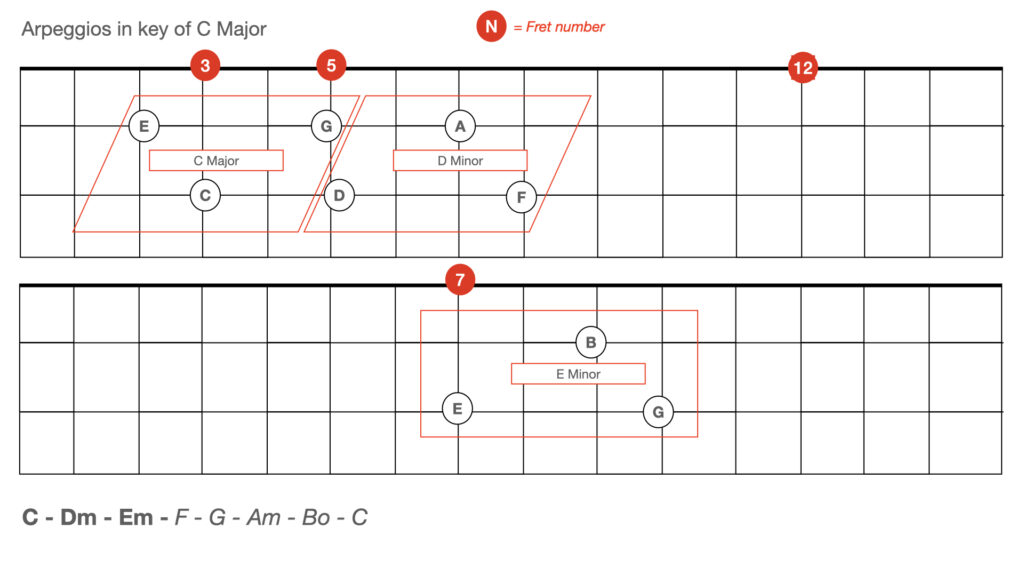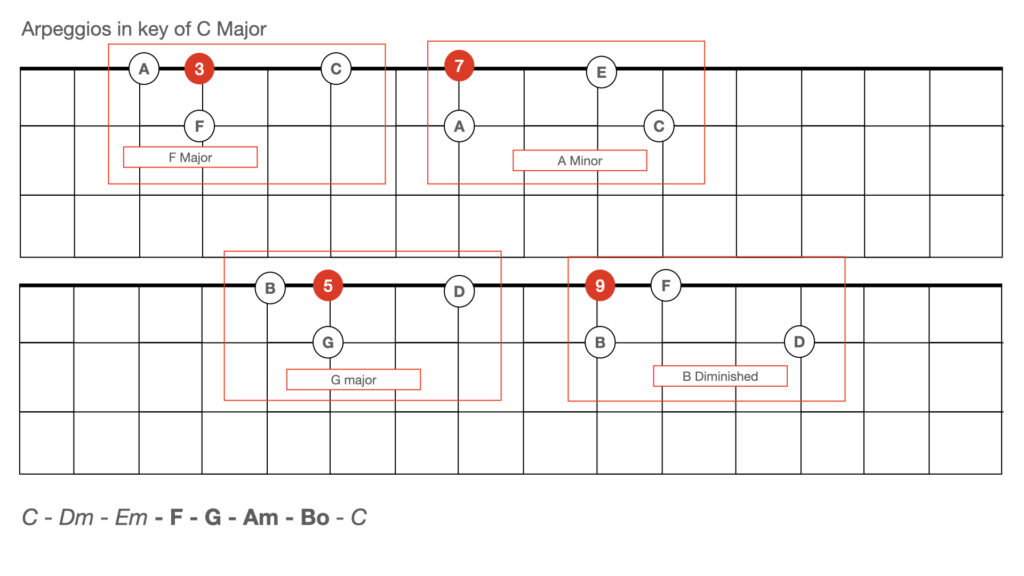An arpeggio is a sequence containing the 1st, 3rd and 5th degree of the scale – so for C major, that is C – E – G. When we practice and arpeggio we start on the root, ascend up using the 3rd and 5th, and finally repeat the root at the next octave, before reversing.
So for C arpeggio, we would play
C (low) – E – G – C (high) – G – E – C (low)
(If we don’t define the scale type – e.g. major or minor, it is assumed to be major)
G major
The first arpeggio we learn on the bass is usually the G arpeggio, as shown below. The fingering is always the same ascending and descending, so only the ascending fingering is shown.
Fingering for G is all first position (as we can use the open strings)
Notes are
- G (2nd finger
- B (1st Finger)
- D (open)
- G (open)

A major
Fingering uses 2nd position (for the C#) and 1st position (for the E and top A)
Notes are
- A (open)
- C# (4th finger)
- E (1st finger)
- A (1st finger)

E major
Fingering uses 2nd position (for the G#) and 1st position (for the B and top E)
Notes are
- E (open)
- G# (4th finger)
- B (1st finger)
- E (1st finger)

D major
Fingering uses 1st position (for the F# and A) and 3rd position (for the top D)
Notes are
- D (open)
- B (4th finger)
- A (1st finger)
- D (4th finger)

Closed position arpeggio
We can play an arpeggio from any position on the bass using the same fingering – this is because the strings are all equally spaced.
The following shows the fingerling for the C major arpeggio, but we can shift the same fingering to the appropriate starting position to play any other major arpeggio. Note that:
- The root note is played with the second finger
- Which ever position we start in , we play the first two notes in that position
- We then have to shift up 1 position to play the next 2 notes (with 4th finger)

Closed Arpeggio Scales
If we play a chord on every note of the scale, then we get a mixture of major and minor, plus a diminished, as shown below. (Note that all the examples in this module use the scale of C major – I.e. all the white notes on a piano)
| C | Major | C – E – G |
| D | Minor | D – F – A |
| E | Minor | E – G – B |
| F | Major | F – A – C |
| G | Major | G – B – D |
| A | Minor | A – C – E |
| B | Diminished | B – D – F |
An arpeggio is simply each note of the chord played separately, one after the other, in other words, the notes in the third column above. So a C major arpeggio is C, followed by E, followed by G. A D minor arpeggio is D, followed by F, followed by A, etc.
This means that there are three different note matters for each of the three different arpeggio types, and these are explained in the next sections.
Major Arpeggio Shape

If we take the starting note (known as the root) of a major chord, then the next note can be found on the next higher string, one fret back (lower). The final note is found on the same string, 3 frets along. Although it seems intuitive to play the root with the first finger, if we use the second finger, then the first finger is already in place, ready for the next string up. A shift of the hand one fret up the neck means that the final note can ebe played with the fourth finger, as shown above.
The above is the fingering for a C major chord, but the same pattern can be applied to any major chord, depending on where the root note (2nd finger) is placed.
Minor Arpeggio Shape

If we take the starting note (known as the root) of a minor chord, then the next note can be found on the same string, three frets forward (higher). The final note is found on the next string up, one fret back (lower). If we play the root note with the first finger, and then shift our hand one free up, the next note can be played with the fourth finger. The final note can then be played on the next string up using the second finger, without moving the hand again.
The above is the fingering for a D minor chord, but the same pattern can be applied to any minor chord, depending on where the root note (1st finger) is placed.
Diminished Arpeggio Shape

If we take the starting note (known as the root) of a diminished chord, then the next note can be found on the same string, three frets forward (higher). The final note is found on the next string up, two frets back (lower). Note how this differs from the minor chord (previous page).
If we play the root note with the first finger, and then shift our hand one free up, the next note can be played with the fourth finger. The final note can then be played on the next string up using the first finger, without moving the hand again.
The above is the fingering for a B diminished chord, but the same pattern can be applied to any minor chord, depending on where the root note (1st finger) is placed.
Summary
An arpeggio is each note of a chord played separately, in sequence (e.g. C – E – G)
Major chords
- Starts with the second finger
- The next note is played on the next string up, with the first finger
- Shift after playing the second note
Minor / Diminished chords
- Starts with the first finger
- The next note is played with the fourth finger on the same string
- The final note is played on the next string up.
- Shift after playing the first note
| Major Chord | 2 – 1 – shift – 4 |
| Minor Chord | 1 – shift – 4 – 2 |
| Diminished Chord | 1 – shift – 4 – 1 |
Arpeggios in the scale of C
If we play an arpeggio on each note pf the scale, we get a sequence of
Major – Minor – Minor – Major – Major – Minor – Diminished
A good exercise is to take a key and play these in sequence. The following 2 images show the arpeggios in sequence for the key of C.
The first three arpeggios are C major, D minor and Eminor and these are played starting on the A string.

These are followed by F major, G major, A minor and B diminished, played starting on the D string. Note especially the difference in the pattern between A minor and B diminished.
